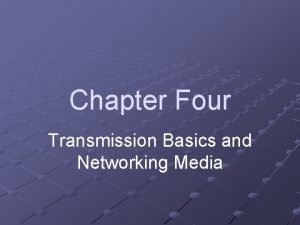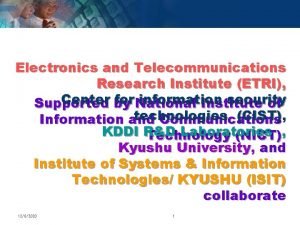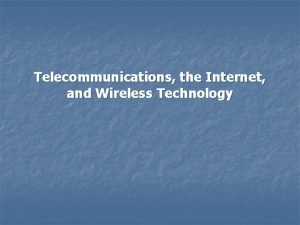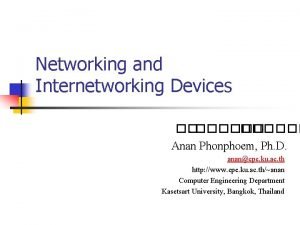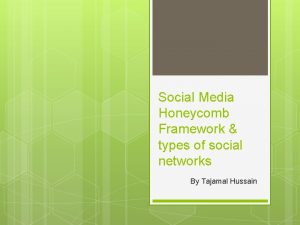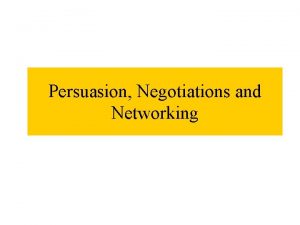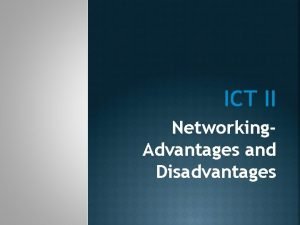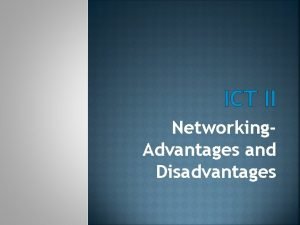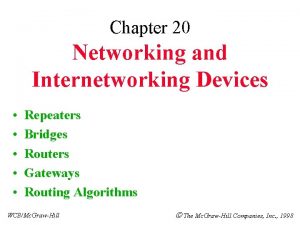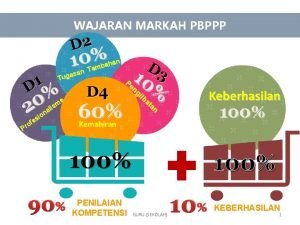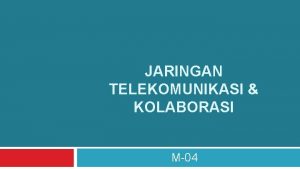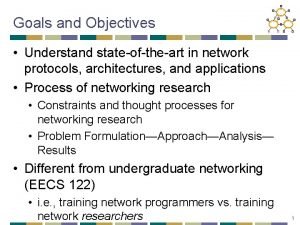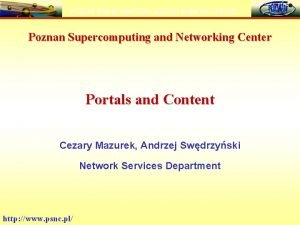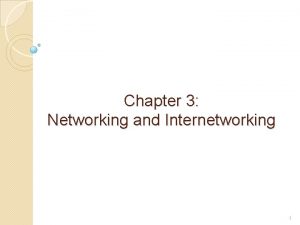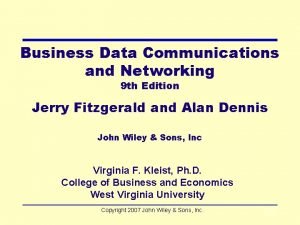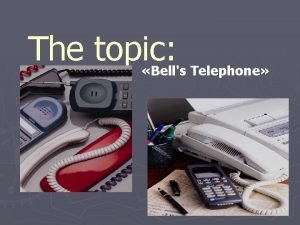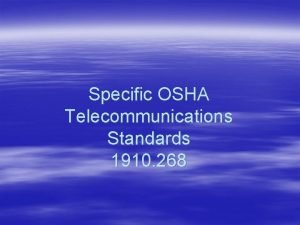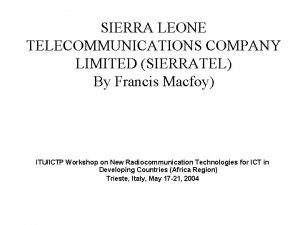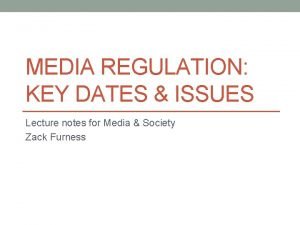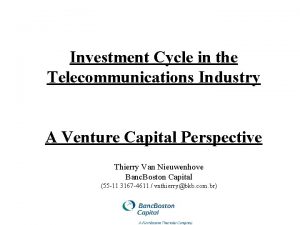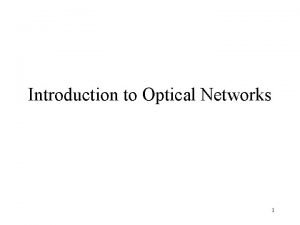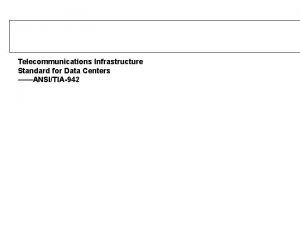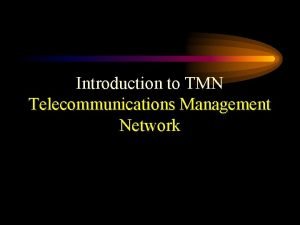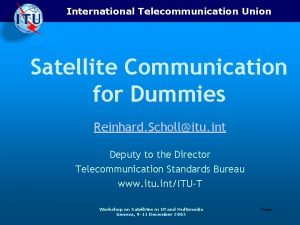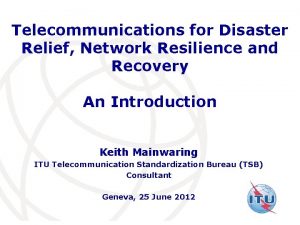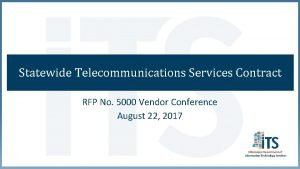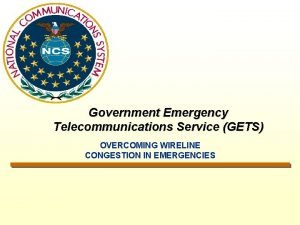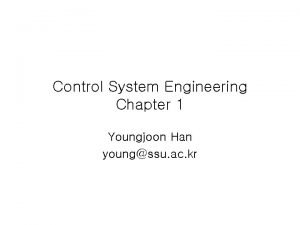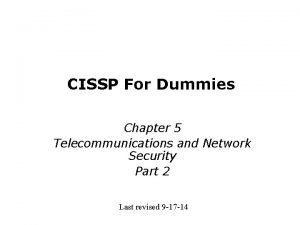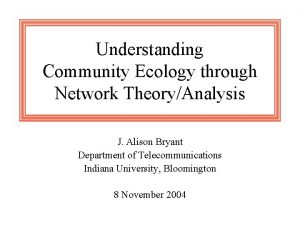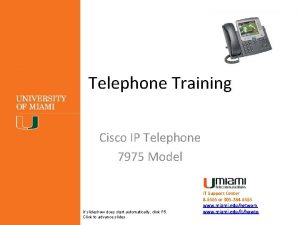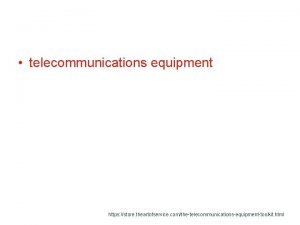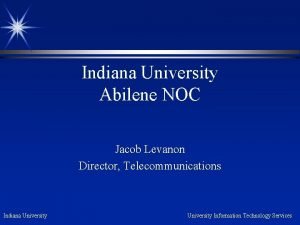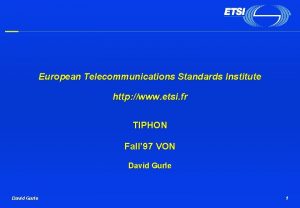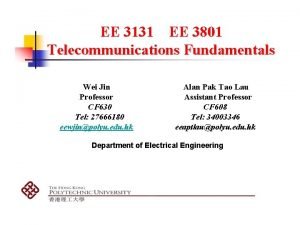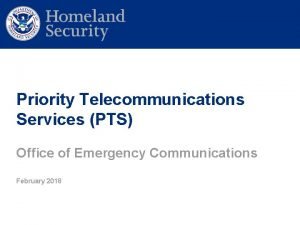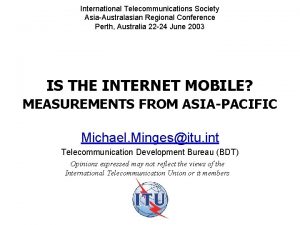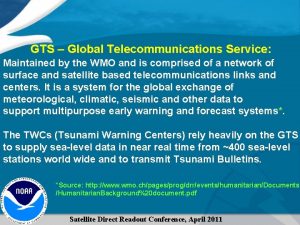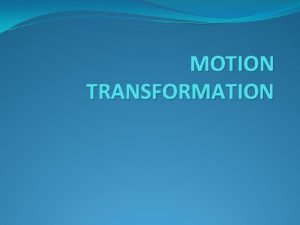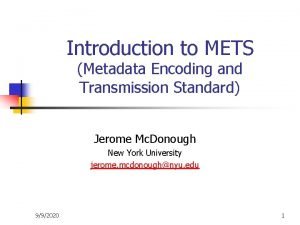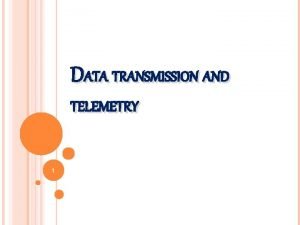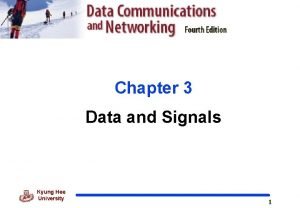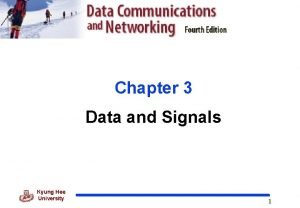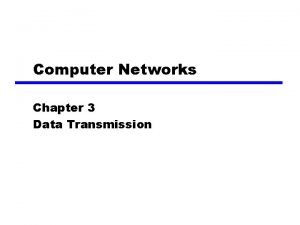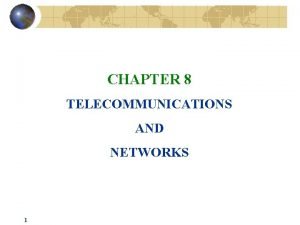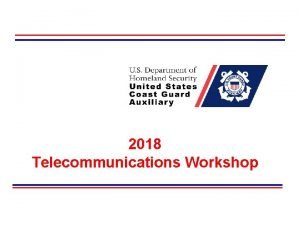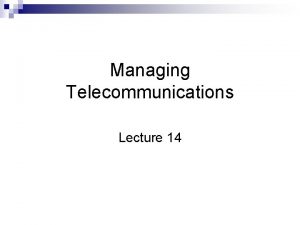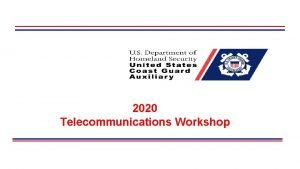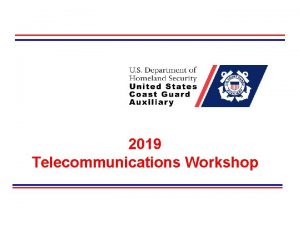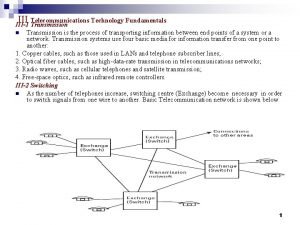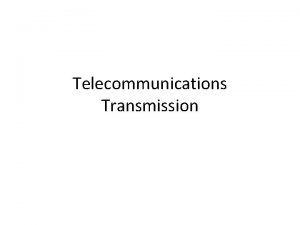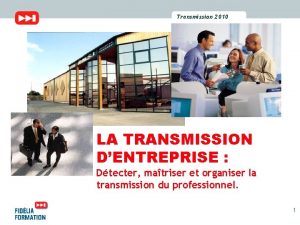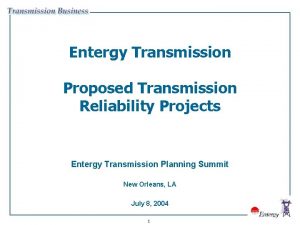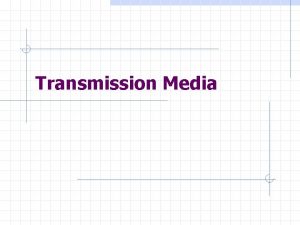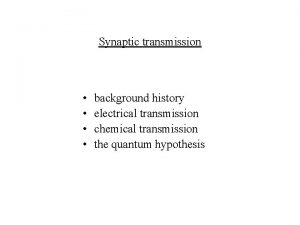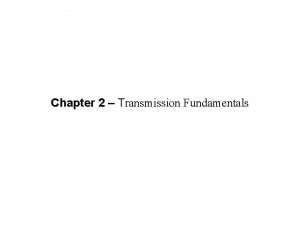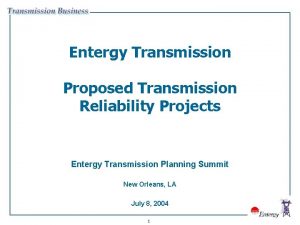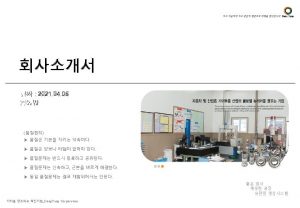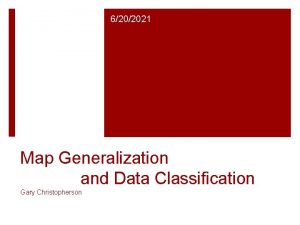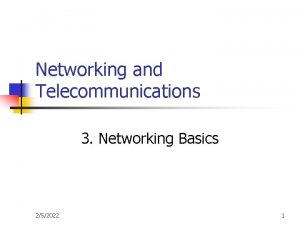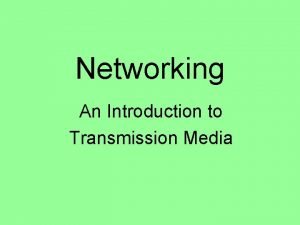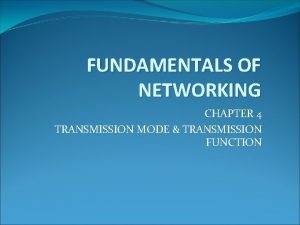Networking and Telecommunications 2 Telecommunications 6202021 1 Transmission
































































- Slides: 64

Networking and Telecommunications 2. Telecommunications 6/20/2021 1

Transmission Characteristics o Medium n n n 6/20/2021 Air Waves – (satellite, microwaves, wireless lans (infrared, radio waves) Electrical /Copper (Twisted Pair, Coax) Light (fiber optic via glass/plastic cable) 2

o Transmission Signals n Parallel - all 8 bits at same time n serial – 1 bit at a time (rs 232), sequential o Transmission Types n Asynchronous – start/stop bits, one character at a time n Synchronous – fast, multiple characters in a block of data. No start/stop bits. 6/20/2021 3

6/20/2021 4

6/20/2021 5

6/20/2021 6

6/20/2021 7

o Analog (continuous sine wave) n Watch (with hands), speedometer o digital transmissions (discrete pulses of 0 or 1) n n 6/20/2021 Computers/binary TV-discrete channels 8

Analog vs. Digital o Internal to Computer (digital, binary) o Transmissions – originally analog n Phone systems – analog totally at first n Computers – used modems to talk over analog phone lines (and connections between CO were analog) n Today – Connections between CO are digital. Connections between home and CO (last mile) are still mostly analog n Cable Modems and DSL – connections from home becoming Digital 6/20/2021 9

Why Digital better then Analog? o Faster (higher capacity) n 56 k vs. Mbps+ o Better data integrity (less errors), distortion of pulses easier to correct o Better Security o Lower Costs Today o No analog to digital conversion needed (no modem) o Easier to integrate voice, video, data 6/20/2021 10

o Transmission Codes = Encoding n n n (Morse Code) EBCDIC (8 bit) ASCII (8 bit vs 7 bit) o Parity – Even vs. Odd o Half Duplex vs. Full Duplex 6/20/2021 11

EBCDIC vs. ASCII Character 6/20/2021 EBCDIC (link) ASCII A 1100 0001 0100 0001 B 1100 0010 0100 0010 Z 1110 1001 0101 1010 5 1111 0101 0011 0101 ! 0101 1010 0001 12

Morse Code 6/20/2021 13

6/20/2021 14

Waves • Sound, Electrical, Radio, Electromagnetic • Sine Wave, measured in Hertz (Hz) • Characteristics – Amplitude and Frequency • Bandwidth – difference from high to low frequency range 6/20/2021 15

o Speed (modems) n Baud vs. BPS p 300, 1200, 2400, 9600, 14. 4, 28. 8, 56 k 6/20/2021 16

Modems 6/20/2021 17

Circuit Switching Networks o “Temporary", "dedicated", communications channel o Voice (phone) 6/20/2021 18

Packet Switching Networks o Store and forward, non-dedicated o Shared communications channel (packets interleaved on same line) o Packets may take different paths, arrive in different order (reassemble at end) o X. 25 – old WAN standard for PSN o Useful for data 6/20/2021 19

6/20/2021 20

Telecom Hardware o Hosts (mainframe, mini) o Micros, workstations (desktop systems) o Terminals (vt 100, 3270, X-terminals) o Automatic Teller Machines (ATM - Banks) o POS (Point of Sales - cash registers) o Fax o Satellite Dishes, Satellites, radar towers o Terminal Server (Access Server) o MUX (multiplexer) - TDM and FDM o Modems 6/20/2021 21

Satellite Dish ATM Machine Fax Machine Terminal 6/20/2021 22

Terminal Servers/Access Servers o Connect modem pool to internal network o Allows outside users to connect in o And internal users to dial-out o Authentication is normally used 6/20/2021 23

6/20/2021 24

Multiplexers o Allows multiple systems to share single common communications channel o Often used with mainframes/terminals, as well as phone systems o 2 Main Methods used: n n 6/20/2021 TDM – Time Division Multiplexing FDM – Frequency Division Multiplexing 25

6/20/2021 26

6/20/2021 27

Transmission (telecom. ) Media o electrical/copper: n Phone wire n TP - 2 pair (4 wire, RJ-11), 4 pair (8 wire, RJ- 45) n Coax n rs 232 o light: fiber optic (glass/plastic) o air: satellite/microwave 6/20/2021 28

Fiber Optics Cable Phone Cable (RJ-11) 6/20/2021 29

o Dial-up lines - analog, non-dedicated, (POTS -Plain Old Telephone Service) o Leased lines - digital, dedicated, often fiber-based n n 6/20/2021 56 k T 1 - 1. 544 Mbps T 3 - 44 Mbps OC 3/OC 12 30

Modems o POTS (Plain Old Telephone Service) o Modulator/demodulator, digital-->analog-->digital o Carrier wave (base, neutral wave) n Amplitude modulation (am), frequency modulation (fm) n Phase modulation (like radio, am/fm) 6/20/2021 31

6/20/2021 32

6/20/2021 33

6/20/2021 34

Frequency Modulation of a Carrier Wave 6/20/2021 35

o Baud vs. bps - detectable events (signaling events) n Detect changes in carrier wave o Types of modems - internal/external 6/20/2021 36

Modem Terms o Standards - V. 32 (9600), V. 32 bis (14, 400 or 14. 4) o V. 34 (28. 8), V. 90 (56 k) ---> 56 k max speed o Data compression o Error detection (parity, checksum) o Encryption 6/20/2021 37

Internal Modem External Modem 6/20/2021 38

Cable and DSL Modems o Also called broadband o Sometimes 56 k and below is referred to as narrowband o Higher speeds then 56 k and always online (may be security risk) 6/20/2021 39

DSL Modem Cable Modem 6/20/2021 40

Cable Modems o Cable- digital modem, higher speeds (500 k to 2 meg) o Different upload/download speeds o Shared technology o Uses Cable TV coax cable o Security Concerns 6/20/2021 41

DSL o Digital Subscriber Line - digital modem o Fast speeds but typically less then cable modems o Different upload/download speeds o switched/dedicated technology o Uses new installed line or existing phone line with filters o Speeds of 144 k up to 6 meg o Typically 144 k to 600 k for home users 6/20/2021 42

Bandwidth o Speed o Info carrying capacity of a transmission facility o Range of frequencies, given in hertz (hz), Cycles/sec, that can be accommodated without signal degredation o voice lines 3000 hz (300 to 3300 hz) 6/20/2021 43

Note – DSL and Cable Modems range from 500, 000 bps to 2, 000 bps and thus would be in the around the T 1 range (2 -4 lane highway). (wireless is similar) 6/20/2021 44

Transmission Problems o Attenuation - loss of signal strength over a distance o Crosstalk - interference from neighboring wires o EMI/RFI - electro magnetic interferenceradio frequency interference o Line noise o Solutions - amplifiers, repeaters, shielding, twisted pair, fiber 6/20/2021 45

6/20/2021 46

6/20/2021 47

RS-232 o Asynch. serial communications standard (1969) o 25 pins (DB-25), copper based (electrical signal) o Handshaking (modems) o DCE/DTE o Null modem connection o 50 feet max o Used with modems, printers, terminals o Typical 2, 3, 7 (send, receive, ground) 6/20/2021 48

RS-232 6/20/2021 49

6/20/2021 50

6/20/2021 51

RS-232 6/20/2021 52

RS-232 6/20/2021 53

RS-232 6/20/2021 54

Summary 6/20/2021 55

Telecommunications o Low level n Bits n Encoding n Parity n Duplex n Serial n Asynch n etc. . 6/20/2021 56

Hardware o Modems o Mux o T 1 o T 3 o terminal server n (access server) o rs 232 o etc. . 6/20/2021 57

Software o Connect to host n telnet/tn 3270/ssh n terminal emulation n log into host n windows terminal n hyperterminal o File transfer n ftp/sftp 6/20/2021 58

Fun Facts o 1876 – Bell “electrical speech machine” o 1878 – 1 st phone book n New Haven Conn. , 1 page (50 names) o 1883 – 1 st yellow pages. Why yellow? o 1929 – 1 st President with phone in White House ? ? o (Herbert Hoover) 6/20/2021 59

Herbert Hoover 6/20/2021 60

More Fun Facts o Alexander Graham Bell – 29 telephone n n Photophone (speech via light waves) Bell and Elisha Gray (2 hours apart) o First Rotary Phone (non crank) – 1929 o First mobile phone – 1924 NYC police 6/20/2021 61

6/20/2021 62

6/20/2021 63

THE END 6/20/2021 64
 Transmission basics and networking media
Transmission basics and networking media Software defined networking vs traditional
Software defined networking vs traditional Telecommunications and data communications
Telecommunications and data communications Electronics and telecommunications research institute
Electronics and telecommunications research institute Telecommunications, the internet, and wireless technology
Telecommunications, the internet, and wireless technology What are wireless devices and the wireless revolution
What are wireless devices and the wireless revolution Difference lan wan
Difference lan wan Networking and internetworking devices
Networking and internetworking devices Backbone network components
Backbone network components Business data communication and networking
Business data communication and networking Social media honeycomb
Social media honeycomb What is persuasion and networking
What is persuasion and networking Disadvantages of networking computers
Disadvantages of networking computers Ictii
Ictii Computer network assignment
Computer network assignment Networking and internetworking devices
Networking and internetworking devices Jalinan dan jaringan dalam pbppp
Jalinan dan jaringan dalam pbppp Pengertian kolaborasi jaringan
Pengertian kolaborasi jaringan Goals of network layer
Goals of network layer Analogue and digital transmission in computer networks
Analogue and digital transmission in computer networks Introduction to data communications and networking
Introduction to data communications and networking Poznan supercomputing and networking center
Poznan supercomputing and networking center Networking and internetworking
Networking and internetworking Error correction in computer networks
Error correction in computer networks Optical switching and networking
Optical switching and networking Business data communications and networking
Business data communications and networking A pioneer in the field of telecommunications
A pioneer in the field of telecommunications Telecom risk management
Telecom risk management Osha telecommunications standards
Osha telecommunications standards Sierra leone telecommunications company
Sierra leone telecommunications company Telecommunications act of 1996
Telecommunications act of 1996 Venture capital telecommunications
Venture capital telecommunications Telecommunications network architecture
Telecommunications network architecture Unstructured cabling
Unstructured cabling Tmn model is defined by
Tmn model is defined by Telecommunication for dummies
Telecommunication for dummies Disaster recovery telecommunications
Disaster recovery telecommunications Danswers
Danswers Government emergency telecommunications service
Government emergency telecommunications service Telecommunications engineering
Telecommunications engineering Telecommunications for dummies
Telecommunications for dummies Department of telecommunications
Department of telecommunications Department of telecommunications
Department of telecommunications French telecommunications equipment company
French telecommunications equipment company Digital telecommunications
Digital telecommunications Iu telecommunications
Iu telecommunications European telecommunications standards institute
European telecommunications standards institute Digital telecommunications
Digital telecommunications Pts
Pts International telecommunications society
International telecommunications society Wireless telecommunications industry analysis
Wireless telecommunications industry analysis Gts telecommunications
Gts telecommunications Solar power satellites and microwave power transmission
Solar power satellites and microwave power transmission Motion transmission systems
Motion transmission systems Mets standard
Mets standard Puncture resistant container
Puncture resistant container Advantages of digital modulation
Advantages of digital modulation Transmission of telemetry
Transmission of telemetry Baseband and broadband transmission
Baseband and broadband transmission Baseband and broadband transmission
Baseband and broadband transmission Chapter 19 disease transmission and infection prevention
Chapter 19 disease transmission and infection prevention Reflection refraction absorption transmission
Reflection refraction absorption transmission Analog digital transmission
Analog digital transmission Transmission terminology
Transmission terminology Digital data transmission
Digital data transmission
